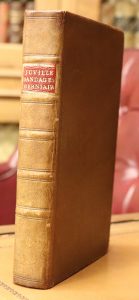 Jean Juville, identified in French dictionaries and catalogs as Juville, hernia expert, was an 18th century surgeon educated at the Royal College of Surgery in Paris, and a truss maker.
Jean Juville, identified in French dictionaries and catalogs as Juville, hernia expert, was an 18th century surgeon educated at the Royal College of Surgery in Paris, and a truss maker.
Before publishing his principal work on hernia bandages (Traité des bandages herniaires, Paris 1786), he already had forty years of experience practicing surgery, studying and perfecting these instruments. He presented the bandages of his invention to the Academy of Sciences in 1773, and published extensively on the subject in the Journal de Medicine in 1775, 1777, and 1783. His name was well known and respected. There was no author writing about hernia bandages in the late 18th and early 19th century who would not refer to or talk about this Parisian truss maker. Juville’s treatise is considered the best 18th century work on the subject.
Traité des bandages herniaires is remarkable in many aspects. The author provides a history of bandages, discusses the principles of constructing them, illustrates and describes different models of ingenious belts and other appliances, offers his observations on their uses in correcting hernias and prolapses, and offers special comments on bandages provided for military hospitals. Among the described instruments, there is the innovative rubber pessary, which Juville introduced in 1783 for treating uterine prolapse. It resembled the contraceptive cup currently in use. Moreover, with minor changes it was used for the next 200 years until rubber was replaced by polystyrene plastics in 1950, and more recently by silicon-based materials. The book has 14 engraved color folded plates illustrating with precision each discussed appliance, which increases the attractiveness of his book.
His early admirers praised Juville for “not trying to cure hernia in adults by the use of his bandages” and described him as a real artist who was passionate about his profession. Modern researchers suggest that the use of spectacular illustrations and color were intentional, so that his treatise could double as a product catalog for his trusses.
The copy of this book in Falk Library is part of the Mark Ravitch Collection. It can be viewed in the Rare Book Room by appointment.
~Gosia Fort